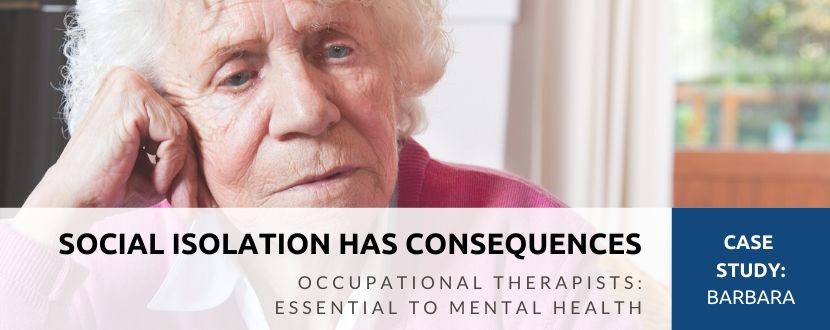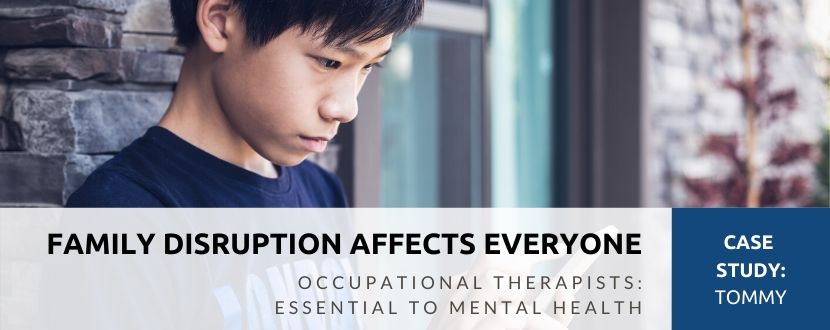
Now more than ever, we need “all hands-on deck” to help Canadians with the mental health care they need following the unprecedented disruption that COVID-19 has wreaked on everyday lives. The Mental Health Commission refers to an ‘echo pandemic’ of mental health impacts in the wake of COVID-19 – a critical societal issue for which OTs are an essential part of the solution.
Unfortunately, most Canadians cannot access occupational therapy services as occupational therapy is not covered under most public and private health care plans. OTs must take action now, to inform decision makers that occupational therapists are essential to mental health care in Canada.
| |
Send this letter to your employer/union/insurance company asking for OT to be included in your health plan. |
Download and share the COVID-19 mental health case studies, also available below.
| |
|
|
Occupational therapists, or OTs, are essential to addressing mental health issues, with extensive skills and knowledge that are relevant and needed for the toll that this pandemic is exacting from Canadians – during the crisis and in its aftermath. OTs are poised to take action on overcoming the disruption that COVID-19 has brought to everyday lives and emotional well-being. Occupational therapy is a low cost, high impact solution that needs inclusion and funding as Canada starts its long recovery.
We’re all in this together. Occupational therapists are essential to mental health.

Since Frank’s death last year, Barbara has managed to stay in their home despite increasingly frail health, a couple of falls, the classic toast and tea diet, and a diminishing social circle. The pandemic and resulting lockdown for individuals in her high-risk cohort has made her world very small. She was already grieving the loss of her partner, but now her sense of loss has become overwhelming. She can’t see her children and grandchildren who live out of town, she does not have or use a computer, and she is disconnected from her usual social encounters at the store and at church. She almost always feels sad and while the thought of society reopening post-pandemic should cheer her up, she instead feels frightened of the unknown and anxious whether she can move forward independently. Barbara needs an occupational therapist.
Depression and anxiety can spiral out of control during a crisis, especially in the absence of emotional support and social contact. Profound feelings of isolation can suppress an individual’s will to take charge of their own life…and rob an older person of happiness in their final years. Here is some of what an occupational therapist, or ‘OT’, can do for Barbara:
- Build a new routine that focusses on what Barbara CAN do instead of what she CAN’T do on her own…foster a renewed sense of confidence by breaking down activities into manageable steps.
- Identify and find solutions to narrow the gaps between what Barbara can do and wants to do, such as finding opportunities for socialization that are safe, achievable and attainable in her community.
- Refer to other team members, like a physiotherapist to help improve Barbara’s mobility and a dietician to provide education on a healthy diet. Work with Barbara to overcome any roadblocks to adopting these new recommendations.
- Modify Barbara’s home affordably and effectively to brighten her space, enable easier food preparation, move or remove items that might cause a fall and recommend mobility aids or other equipment where needed.
 Download Social Isolation case study.
Download Social Isolation case study.

Tommy misses his in-class sessions with occupational therapist Tanya. Tanya has been working with Tommy regularly for the past two years and has helped him establish a routine that supports his particular needs related to autism spectrum disorder. At ten years of age, Tommy has been able to stay integrated into a classroom with his peers, and his family has been able to learn some of the strategies to help him cope better at home. Now that the pandemic has caused school lockdown for the remainder of the school year, Tanya’s services have been cut off. Tommy is missing her, feeling victimized and anxious without her usual guidance. He is acting out terribly, becoming frustrated with even simple tasks at home, unable to control his emotions, and can’t respect barriers like a closed door that allow his parents to work from home. He has disrupted the whole family’s schedule, leaving his parents and younger siblings in a state of upset and sleeplessness that is affecting everyone’s wellbeing. With months ahead of them before school reopens, and with therapy services becoming accessible again, Tommy’s parents know what they need. Tommy and his family need an occupational therapist.
- Meet with Tommy's parents one on one to help them understand what his behaviour is communicating, provide education on the concept of stress, and identify ways Tommy (and other members of the family) can release frustration that are appropriate and specific to their family culture and physical space.
- Determine the capacity of his parents to learn and implement cognitive strategies for themselves and Tommy including: matching the size of reaction to the size of problem, making a visual 'map' of the impact Tommy's actions have on others and how what he does makes others feel.
- Help Tommy and his parents establish a firm and predictable daily routine, including developing rules about respecting what his parents are doing when the door is closed.
- Encourage a bedtime routine to improve sleep for Tommy that includes no screen time before bed, and comforts like a weighted blanket, soothing music or white noise and stuffies.
- Work with Tommy and his parents to set up activities and a visual schedule for Tommy during the times when his parents are not available to be with him physically.
- Encourage Tommy's parents to take photos of him doing what is expected, and use these to make a book or social story which offers comfort and enables Tommy to understand the expectations they have for him within the home environment.
- Finally, set up a designated working space for Tommy with flexible but supported seating for completing schoolwork for example a wedged wiggle seat or chair ball and room to stand or lay on his tummy for a break from sitting.
 Download Family Disruption case study.
Download Family Disruption case study.

Randy and his staff have been working from home for almost three months and the announcement that the office will reopen fills him with dread. He has been glued to the daily news - hours of it - has not been outside much at all, has been overeating, working into the middle of the night and not sleeping. Sleeping aids and alcohol have been his ‘go to’ solutions and he has developed such social anxiety that he is now physically sick at the thought of being back in a position of authority in a structured workplace. Not only is his world spinning out of control but Randy is unsure of who he really is and what his world consists of. He is afraid and feels he is being scrutinized, judged, and victimized. Randy needs an occupational therapist.
Sarah is part of an advertising creative team that has been working from home for almost three months and the announcement that this will become her permanent workplace environment fills her with sadness. Sarah recently completed her degree, is ambitious, and had plans of rapidly moving up in her organization and, one day, opening her own boutique agency. Now she has an overwhelming feeling that her hopes and dreams will never come to fruition – she doesn’t feel that she ‘shows’ well in online meetings, she has trouble interpreting what her clients are asking her, she senses her work is ‘flat’ - lacking the creative kick she gets from a collaborative workspace. Sarah extends these workplace worries into her whole life – she isn’t in a relationship and feels she will never meet someone now, she set expectations for herself and her career, which she shared with family and friends, and now feels a profound sense of failure. She wants to become invisible. She no longer turns on the video during meetings, she is late with projects, and she has withdrawn into loneliness and depression. Sarah needs an occupational therapist.
Amir was working as a bartender at Stu’s Pub which closed its doors at the outset of the pandemic and has unfortunately decided they can’t reopen. Amir is relatively new to Canada and saw a way forward with bartending that didn’t require a formal education or perfect language skills – just honesty, loyalty, hard work and an outgoing personality. He has a young family and although they are receiving some government relief, the stress of how to support his family longer term and the limits of the job market for someone with his skill set is leaving him anxious, withdrawn and often angry with those around him. With his kids out of school and running around the apartment, with few social connections to anyone in Canada, and with money a constant worry, Amir feels his dreams of coming to Canada have been shattered and the resulting stress is bringing him to a breaking point. Amir needs an occupational therapist.
Anxiety, depression, and stress.
Three conditions that can come from many sources, be triggered by a crisis, affect individual lives in a variety of ways – possibly for the first time – and have heartbreaking outcomes. Here is some of what an occupational therapist, or ‘OT’, can do for Randy, Sarah and Amir:
- Talk through and establish a list of the activities they need and want to do every day that are important to them. That might include aspects of their physical, emotional and spiritual self.
- Help them identify their personal strengths and the social supports and resources in their life that they can draw upon.
- Support them to find activities that bring a sense of joy and meaning, for example daily walks, mediation or mindfulness, yoga.
- Set a short-term goal or two – something achievable that would provide a sense of hope, progress and success.
- Map out a routine – either reconnecting with what worked before or developing something new that might feel like a new normal. Broaden this to include family where needed.
- Teach and practice healthy coping strategies and skills such as grounding and breathing exercises or assertive communication.
- Set up the physical environment to support the routine for example, a reminder system, organized work environment and proper ergonomic positioning at the workstation.
- Highlight progress and celebrate milestones, all while working towards a long-term goal.
 Download Returning to Work case studies.
Download Returning to Work case studies.